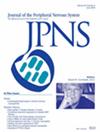Paraneoplastic Leucine Zipper 4 IgG Associated Motor-Predominant Polyradiculoneuropathy
Abstract
Background and Aims
Leucine Zipper 4 (LUZP4)-immunoglobulin G (IgG) is a novel antibody implicated in germ cell tumor-related paraneoplastic neurologic syndrome. We report a case of painful, progressive tetraparesis associated with testicular seminoma and LUZP4-IgG seropositivity.
Case Report
A 51-year-old male presented with a 5-week history of lower limb predominant progressive weakness. Nerve conduction studies (NCS) and electromyography (EMG) revealed a subacute axonal polyradiculoneuropathy. MRI lumbar spine showed thickening of the cauda equina and enhancement of the lower thoracic spinal cord/conus. Cerebrospinal fluid (CSF) showed a lymphocytic pleocytosis, three oligoclonal bands, and mildly elevated protein. Initial treatment with intravenous immunoglobulin (IVIG) and prednisone produced temporary improvement. CT targeted retroperitoneal lymph node biopsy revealed a seminoma, which was treated with orchiectomy and chemotherapy. The testicular tissue was consistent with a regressed germ cell tumor. His course was subsequently refractory to IVIG, prednisone, and plasma exchange. LUZP4 antibodies were detected in serum, prompting treatment with cyclophosphamide and prednisone. At the 4-month follow-up, the patient had significant improvement in hand strength and had transitioned from walker to cane.
Interpretation
LUZP4-IgG seropositivity and identification of retroperitoneal seminoma confirmed a paraneoplastic neurologic syndrome, which is a CD8+ T-cell-mediated disorder. Aggressive immunotherapy was initiated, resulting in clinical improvement. This case underscores the importance of identifying specific serologic biomarkers that can inform therapeutic decisions and improve outcomes.

 求助内容:
求助内容: 应助结果提醒方式:
应助结果提醒方式:


